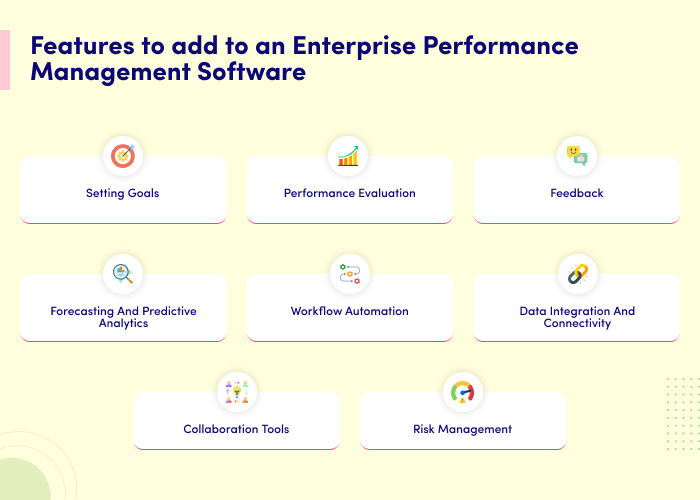Features to add to an Enterprise Performance Management Software

There are various features to add to your custom enterprise performance management solution, but we will cover the most important ones here. Below are the crucial features to never neglect to add to EPMS:
- Setting Goals: It is one of the many crucial elements of Enterprise Performance Management Software. Setting SMART goals helps users make sure they are in line with the goals of the company. It promotes openness and unity by making it easier for managers to communicate objectives to individual staff members.
- Performance evaluation: With the help of this feature, managers can organize and simplify the performance review process, doing away with the need for handwritten documentation and simplifying administrative duties. Managers and staff alike benefit from this time savings, which frees them up to concentrate on more worthwhile tasks.
- Feedback: With the help of this feature, workers may receive feedback from several reviewers, which provides them with insights from a range of stakeholders, including colleagues, superiors, and other workers. It provides a comprehensive understanding of a person’s assets, growth opportunities, and blind spots.
- Forecasting and Predictive Analytics: Predictive modeling algorithms may be integrated to help strategic planning efforts, detect possible dangers, and forecast future trends.
- Workflow Automation: Streamline processes such as approval workflows, data validation, and reconciliation to improve efficiency and reduce manual errors.
- Data Integration and Connectivity: Support integration with various data sources and systems (ERP, CRM, HRIS, etc.) to ensure data accuracy and consistency across the organization.
- Collaboration Tools: Facilitate collaboration among stakeholders by enabling them to share insights, comments, and annotations within the platform.
- Risk Management: Incorporate features for identifying, assessing, and mitigating risks related to financial performance, compliance, and market fluctuations.
The cost of developing an EPMS
- Integration and Personalization: The total cost of development can be greatly increased by including options for customization and smooth interaction with current systems (such as ERP, CRM) to satisfy unique company demands. Moreover, adding customized functionality and guaranteeing application compatibility may raise the cost of development.
- Technology Stack: Development expenses are also influenced by the tech-stack selection, which includes databases, software development frameworks, and third-party integrations. Choosing cutting-edge technologies with broad capabilities, such as AI, ML, etc., may result in greater upfront expenditures but eventually provide an EPM solution that is more reliable and scalable.
- Development: Building a robust backend infrastructure to handle data storage, processing, and integration with other systems will incur development costs. The complexity of the backend architecture and the need for scalability and security will affect costs.
- Development Agency: For the creation of Enterprise Performance Management Software, choosing the best app development firm is essential. The experience, knowledge, and location of the business may all have a big influence on how much it costs to design EPMS.
- Testing and Quality Assurance: Thorough testing and quality assurance are essential to ensure the reliability, performance, and security of the EPMS. Testing costs will depend on the complexity of the system and the scope of testing required.
- Deployment and Support: Consider costs associated with deployment, training, and ongoing support and maintenance of the EPMS after launch. This includes bug fixes, updates, and responding to user feedback.
Thus, creating Enterprise Performance Management Software can cost anywhere from $10K to $100K, or even more if complicated.
Conclusion
Enterprise performance management software is essential for assisting businesses in reaching their strategic goals, increasing productivity, and making well-informed decisions.
With capabilities like goal-setting, performance assessment, feedback channels, forecasting, workflow automation, data integration, teamwork tools, and risk management features, EPMS enables companies to maximize productivity and spur expansion in the cutthroat business world of today.
However, the cost of developing EPMS can vary significantly based on factors such as integration and personalization requirements, technology stack selection, development agency expertise, testing and quality assurance efforts, and ongoing support and maintenance needs.
By carefully considering these factors and investing in the right development resources, businesses can create a tailored EPMS solution that meets their specific needs and delivers tangible value.
FAQs
Can EPMS be customized to align with our organization's unique performance management processes?
How can Enterprise Performance Management Software help organizations mitigate risks related to financial performance and market fluctuations?
What are some key considerations for selecting a development agency to build Enterprise Performance Management Software?
How long does it typically take to deploy an EPMS solution?
What ongoing support and maintenance services are typically provided for EPMS?
Ravi Bhojani is the Chief Marketing Officer (CMO) at Alian Software, where he spearheads the company’s marketing strategies and drives its brand presence in the competitive IT services landscape. With over a decade of experience in the technology and marketing sectors, Ravi has consistently demonstrated his ability to blend innovative marketing techniques with deep industry knowledge to deliver outstanding results.